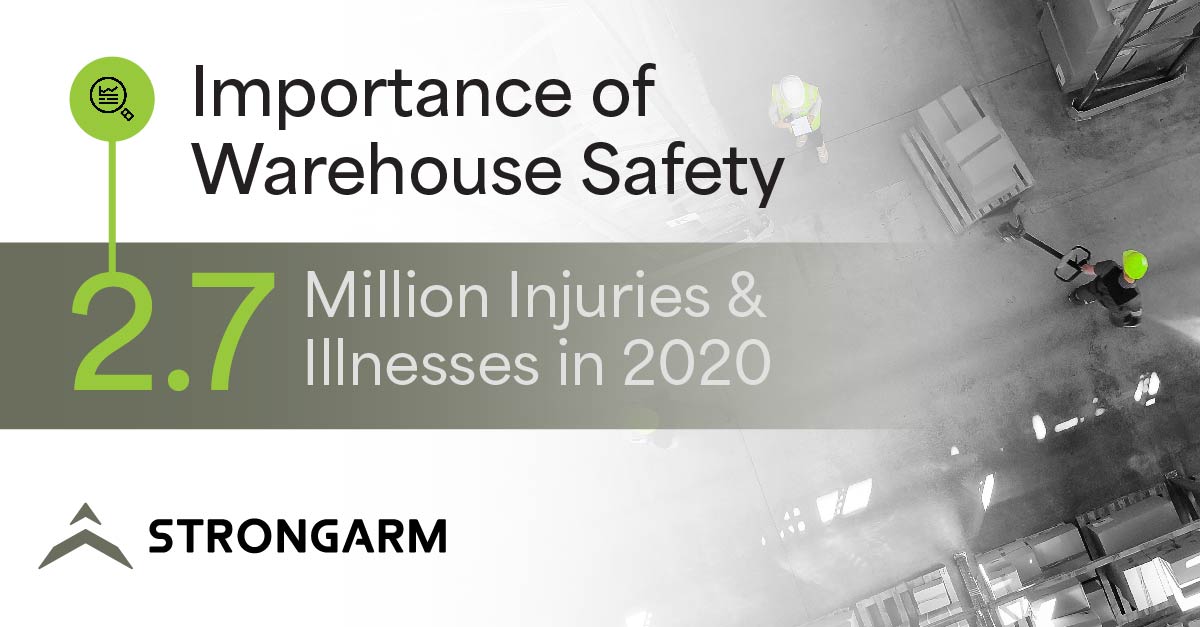Empowering Women in Supply Chain and Warehouse Roles: Prioritizing Safety and Equality
As we begin the celebration of Women’s History Month, it’s crucial to shine a light on the often overlooked contributions of women in traditionally male-dominated industries. Among these sectors, supply chain and warehouse operations stand out, where women are increasingly making their mark despite facing unique challenges. One such challenge is the concerning rate of workplace injuries among women compared to their male counterparts. In this blog, we’ll delve into this issue, examining the types of injuries women in these roles frequently encounter, exploring the factors contributing to their higher injury rates, and most importantly, discussing strategies to enhance safety and promote equality in the workplace.
Understanding the Disparity: Women’s Injury Rates in Supply Chain and Warehousing
In the dynamic realm of supply chain and warehousing, an often overlooked yet critical issue is the disparity in injury rates between male and female workers. Statistics from various studies and reports highlight a significant gap in the occurrence of workplace injuries, underscoring the imperative for targeted interventions to address the underlying challenges.
According to data compiled by the Bureau of Labor Statistics (BLS), women currently make up a little over 30% of the warehousing and storage workforce. and other research organizations, women in supply chain and warehouse roles experience a disproportionately higher rate of injuries compared to their male counterparts. For instance, a study published in the Journal of Occupational and Environmental Medicine found that women working in manual material handling occupations, prevalent in warehouse settings, were at a significantly elevated risk of musculoskeletal injuries compared to men in similar roles.
Furthermore, BLS data on nonfatal occupational injuries and illnesses indicate that women in transportation and warehousing occupations consistently report higher rates of workplace injuries than men. While the exact figures may vary depending on the specific job functions and industry segments, the overall trend points to a concerning pattern of gender disparities in injury rates within these sectors.
Several factors contribute to the elevated risk of injuries among women in supply chain and warehousing roles. Ergonomic challenges, such as inadequate equipment design and improper workstation setup, disproportionately affect female workers, leading to strains, sprains, and other musculoskeletal disorders. Additionally, the physically demanding nature of many tasks, including lifting, carrying, and repetitive motions, can place women at greater risk of injuries, particularly if appropriate training and support are lacking.
Research examining the physiological differences between males and females performing repetitive tasks has shown that despite doing identical tasks females exhibited higher muscular activity as a percentage of their maximum voluntary effort and a higher rate of MSDs of the neck and upper extremities. Although many biological characteristics and social roles for men and women overlap, certain manufacturing jobs and tasks were likely designed to fit traditionally male traits and roles and therefore may require proportionally greater demand for female workers.
Journal of Occupational and Environmental Medicine
Moreover, organizational factors, such as workplace culture, leadership support, and access to resources, may further exacerbate the disparity in injury rates. Gender biases and stereotypes in male-dominated industries can impact women’s experiences and hinder their ability to access safety resources or voice concerns about hazardous working conditions.
Addressing the gender disparities in injury rates requires a multifaceted approach that encompasses ergonomic interventions, targeted training programs, cultural initiatives, and policy changes. By acknowledging the unique challenges faced by women in supply chain and warehousing roles and implementing proactive measures to mitigate risks, organizations can create safer and more equitable workplaces for all employees.
Common Types of Injuries Among Women in Supply Chain and Warehousing
Women typically encounter a range of occupational hazards that can lead to various types of injuries. Understanding these common injuries is crucial for implementing effective prevention strategies and ensuring the well-being of female workers in these roles.
One prevalent type of injury among women in supply chain and warehousing is musculoskeletal disorders (MSDs). These injuries often result from repetitive tasks, prolonged standing, and awkward postures commonly associated with manual material handling, such as lifting, carrying, and sorting goods. MSDs can manifest as strains, sprains, and overuse injuries in the muscles, tendons, and joints, impacting mobility and causing chronic discomfort if left unaddressed.
Furthermore, women in supply chain and warehousing roles are susceptible to injuries resulting from contact with objects and equipment. Striking or being struck by objects, such as falling merchandise or improperly stored inventory, can cause bruises, cuts, and even more severe injuries. Similarly, accidents involving powered industrial trucks, conveyor belts, and other machinery pose significant risks, highlighting the importance of proper training, maintenance, and safety protocols.
Moreover, ergonomic hazards contribute to a range of injuries among female workers, including back pain, neck strain, and carpal tunnel syndrome. Tasks that require repetitive motions, forceful exertions, or awkward postures can lead to cumulative trauma over time, affecting the musculoskeletal system and compromising overall health and well-being.
Addressing these common types of injuries requires a comprehensive approach that integrates ergonomic principles, safety protocols, and employee training. By identifying risk factors and implementing preventive measures such as ergonomic equipment, proper lifting techniques, and hazard awareness training, organizations can minimize the incidence of injuries and create safer working environments for women in supply chain and warehousing roles.
Preventive Measures for Enhancing Women’s Safety in the Workplace
Creating a safe and supportive work environment for women in supply chain and warehouse roles requires a multifaceted approach that addresses the unique challenges they face. By implementing proactive measures and tailored interventions, employers can mitigate risks and promote the well-being of female workers.
Ergonomic Interventions
One crucial aspect of enhancing women’s safety in the workplace involves ergonomic interventions aimed at reducing physical strain and preventing musculoskeletal injuries. Employers can invest in adjustable workstations, ergonomic seating, and tools specifically designed to accommodate the physical differences among workers. By optimizing workstation setups and providing ergonomic training, organizations can minimize the risk of discomfort and injuries resulting from repetitive tasks and awkward postures.
Comprehensive Training Programs
Empowering female workers with the knowledge and skills necessary to perform tasks safely is essential for preventing injuries in the workplace. Comprehensive training programs should cover topics such as proper lifting techniques, ergonomics, hazard recognition, and emergency procedures. By equipping women with the tools and resources they need to navigate potential risks effectively, organizations can foster a culture of safety and empower employees to prioritize their well-being.
Cultural Initiatives
Fostering a culture of safety and inclusion is integral to promoting women’s safety in the workplace. Employers should cultivate an environment where open communication, mutual respect, and collaboration are valued. Encouraging employees to actively participate in safety initiatives, report hazards, and share feedback fosters a sense of ownership and collective responsibility for safety outcomes. By recognizing and addressing gender biases and stereotypes, organizations can create a more equitable and supportive workplace for all employees.
Technological Advancements
Embracing technology and automation can play a significant role in enhancing workplace safety for women in supply chain and warehouse roles. Automated systems, such as conveyor belts, robotic palletizers, and material handling equipment, reduce reliance on manual labor and minimize exposure to hazardous tasks. Additionally, innovative safety technologies, such as proximity sensors, warning systems, and wearable devices, help prevent accidents and mitigate risks in real-time.
Mentorship and Support Networks
Establishing mentorship programs and support networks can provide valuable guidance and resources for women in supply chain and warehouse roles. Pairing female employees with experienced mentors facilitates knowledge sharing, skill development, and career advancement opportunities. Moreover, creating spaces for networking and peer support enables women to exchange ideas, share experiences, and navigate challenges collectively. By fostering mentorship and support networks, organizations demonstrate their commitment to gender equality and professional development in the workplace.
Conclusion
As we commemorate Women’s History Month, let’s commit to creating safer, more inclusive workplaces for women in supply chain and warehouse roles. By addressing the underlying factors contributing to their higher injury rates and implementing proactive measures to enhance safety and equality, we can pave the way for a brighter and more equitable future for all workers in the industry. Together, let’s build a culture where every individual, regardless of gender, can thrive, contribute, and succeed.



